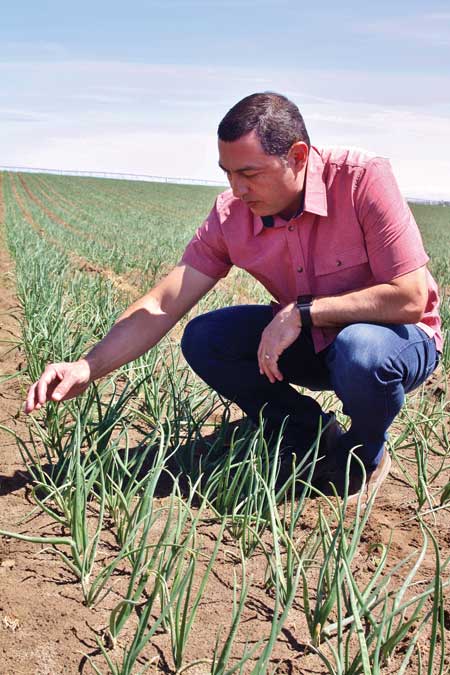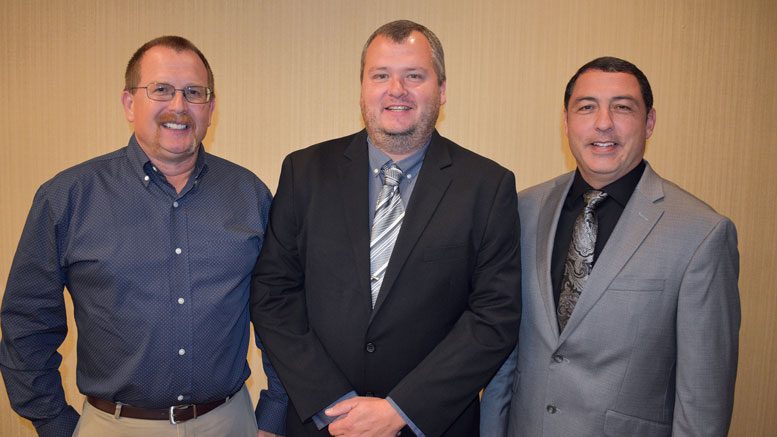|
Click to listen to this article
|
Story and photos by Denise Keller, Editor
It would be hard to argue that Jared Gutierrez hasn’t stepped up to the plate this year. As general manager of Columbia Basin Onion, he’s helping the company navigate the ripple effects of the pandemic. As an industry advocate, he’s taking on leadership roles with the Washington Potato and Onion Association and the National Onion Association.
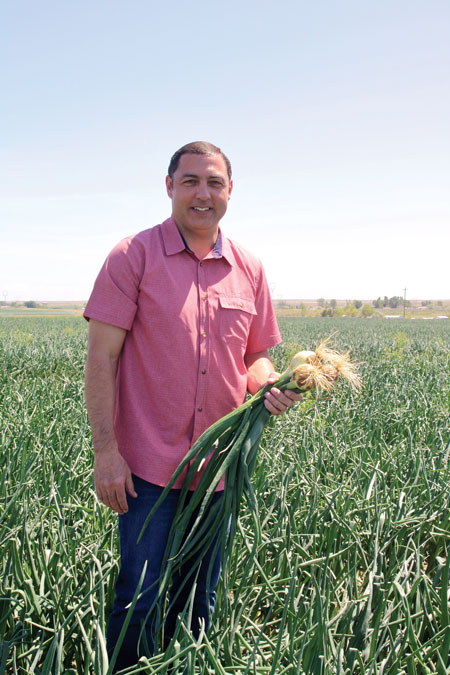
The Advocate
Originally from southeast Idaho, Gutierrez grew up on a small potato farm and farmed with his dad until 2009. He then went to work for Bybee Frozen Foods for several years before taking the job as general manager at Columbia Basin Onion in Hermiston, Oregon, in 2017.
Wanting to cooperate with other growers and take a proactive approach to industry issues, Gutierrez joined the Washington Potato and Onion Association (WPOA), which includes Oregon’s Umatilla and Morrow counties, and helped reestablish the group’s onion committee in the area in 2018. He assumed the role of WPOA vice president in June 2021. Member growers communicate about crop conditions and the market outlook and work together to tackle legislative issues at the state level.
In July, Gutierrez added another title to his resume when he was selected as the National Onion Association (NOA) second vice president at the NOA summer convention. He will fill this position until the annual convention this winter, then serve a two-year term as first vice president and take over as NOA president in 2023.
Gutierrez is a longtime NOA member and has served as a trustee and a member of the legislative and promotion committees. In the last few years, he has become more involved, traveling to Washington D.C. in February 2020 and again this past June. There, he enjoys giving the industry a voice through which to express concerns and bring issues to the attention of legislators.
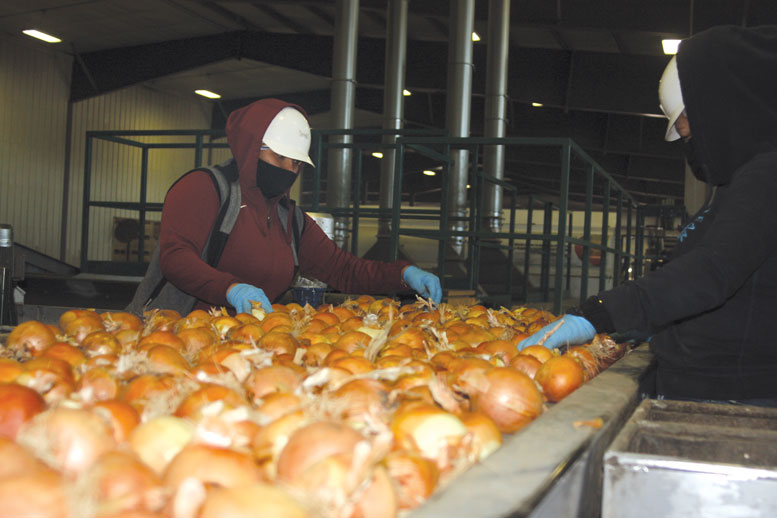
“I find it intriguing to be able to at least present a case or an argument to lawmakers. It keeps you going; it’s a sense of job security. If you’re not fighting for your industry, then what do you have?” Gutierrez says. “It’s nice to be able to relate and communicate the concerns of an industry.”
Gutierrez also enjoys the comradery of working with his peers. There are good people in the mix, he says, and more members are always welcome.
“The NOA and WPOA need all the support they can get. The more people you have united with the same thought and energy and fight, the better off you’re going to be,” Gutierrez says. “I think the work they do goes unnoticed. There are a lot of things that are being battled for sight unseen until people get involved and realize the issues, but yet they were still benefactors of it. These associations help the whole industry. I encourage everyone to put their foot forward and have a voice.”
Looking ahead, Gutierrez expects that the NOA will continue to address the challenges associated with onion imports and work to ensure that marketing orders are sustained and upheld. Other priorities include trying to keep necessary chemicals on the market by presenting research demonstrating their safe use under the Interregional Research Project No. 4 (IR-4 program), and talking to lawmakers about the concerns and issues facing each onion producing state.
“The more they know, the more we hope they’ll fight for us, regardless of partisanship,” Gutierrez says.
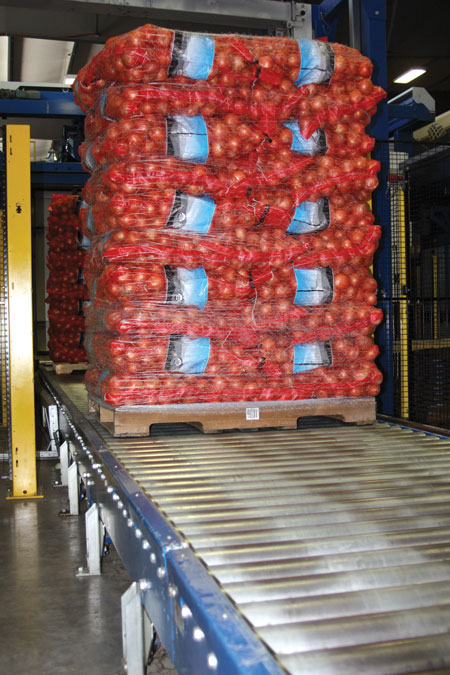
The Manager
In addition to volunteering with onion industry associations, Gutierrez stays busy managing operations at Columbia Basin Onion. The grower-packer-shipper handles 3,500 to 4,000 truckloads of onions per year, with the shed typically running 11 months of the year.
Overwinter onions, which make up about 5 percent of the farm’s onion crop, kick off the new season. Planted in early September of the previous year, they’re harvested around the third week of June. Transplants, accounting for another 5 percent of the crop, are planted in March and harvested in mid-July. The early direct-seed onions follow about a week later and make up 10 percent of the crop. Finally, harvest of the storage onion crop begins in mid-August.
Roughly two-thirds of the onions are grown conventionally, with one-third under organic production. The region experiences good weather for onion production, with a lower elevation allowing for more heat units during the growing season. With ideal weather, planting can begin as early as mid-February, which can give the grower a marketing edge.
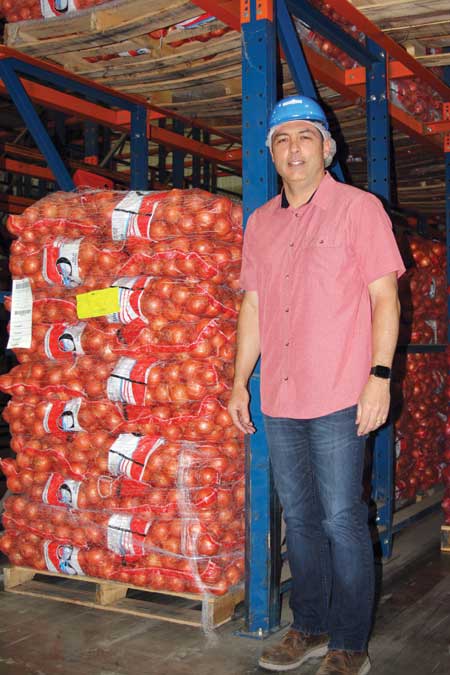
The majority of the onions are sold on the domestic wholesale market. The pandemic, however, shifted the program at Columbia Basin Onion. Sales of larger onions slowed as foodservice halted. Meanwhile, demand for medium onions increased, especially with the creation of the USDA Farmers to Families Food Box Program last spring. The consumer packing line became busy, and retail consumer packaging became in short supply.
“We’ve had these highs and lows. It feels like a roller coaster ride through the 2020 crop season, but you just find new outlets for it and we just push forward,” Gutierrez says, adding that Columbia Basin Onion planted its usual onion program in 2021. “It’s still a little nerve wracking for the upcoming season. We’re trying to be optimistic, and we’re hoping the pandemic gets under control soon.”
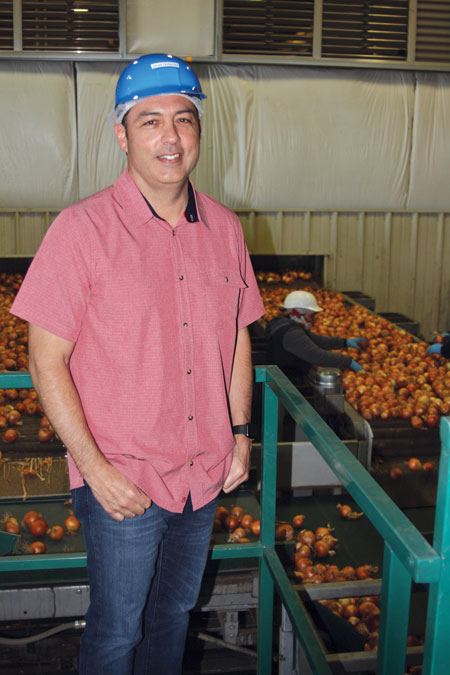
The Future
Given that Columbia Basin Onion’s plant is designed to sustain the foodservice and wholesale market, the pandemic made Gutierrez more aware of the need for additional consumer pack equipment. He is also looking at ways to increase the facility’s efficiency in order to minimize the impact of labor shortages and the rising minimum wage. Columbia Basin Onion uses automated bagging, automated palletizing, and external optics to detect blemishes, sunscald and peeling. The company is also in the research and development phase with an internal optics camera system to scan for internal decay or growth. So far, Gutierrez says, the system works great on yellows and whites, but it’s challenging for cameras to penetrate through a red onion’s dark layers.
Finding innovative solutions to problems in the packing shed, in the field and in the industry is something Gutierrez enjoys. And he’s happy to play a part in shaping the future of farming.
“Farmers are still the backbone of America. That’s really where it’s at,” he says. “You have to find ways to fight the fight, whether you’re fighting imports of the same crop from another country or you’re fighting EPA regulations – water, chemicals, fertilizer – it makes it harder and harder to try to establish what we do. I enjoy fighting those legislative fights.”
